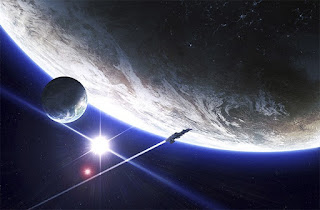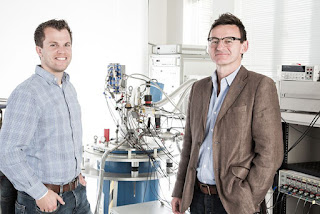 |
| Image Source: Discovery News (link below) |
Topics: Astrophysics, Dyson Sphere, Exoplanets, Kardashev Scale, Kepler Telescope, SETI
There's kind of a rush when you read articles like this, at least initially. Then, you start asking yourself critical thinking questions to "peel away the onion" so to speak. In essence, they've seen some fluctuations in luminosity from a star the Kepler Telescope is observing 1,500 light years away (not exactly across the street). Also humbling we, as the human species on Earth circa 515 CE were essentially savages; beneath any potential advanced aliens' notice.
To quote the Discovery article:
"Follow-up studies focus on two interesting transit events at KIC 8462852, one that was detected between days 788 and 795 of the Kepler mission and between days 1510 to 1570. The researchers have tagged these events as D800 and D1500 respectively. The D800 event appears to have been a single transit causing a star brightness drop-off of 15 percent, whereas D1500 was a burst of several transits, possibly indicating a clump of different objects, forcing a brightness dip of up to 22 percent. To cause such dips in brightness, these transiting objects must be huge.
"The researchers worked through every known possibility, but each solution presented a new problem. For example, they investigated the possibility of some kind of circumstellar disk of dust. However, after looking for the infrared signal associated with these disks, no such signal could be seen. Also, the star is a mature F-type star, approximately 1.5 times the size of our sun. Circumstellar disks are usually found around young stars.
"The researchers also investigate the possibility of a huge planetary collision; could the debris from this smashup be creating this strange signal? The likelihood of us seeing a planetary collision is extremely low. There is no evidence in data taken by NASA’s Wide-field Infrared Survey Explorer (WISE) that a collision happened, creating a very tiny window of opportunity between WISE’s mission end and the beginning of Kepler’s mission (of a few years) for an astronomically unlikely cosmic event like this to occur.
"The only natural explanation favored by the researchers seems to focus on an intervening clump of exocomets."
All of that is fairly reasonable. If you explore the many links in the article, you'll get to the actual Physics arXiv paper in one of its conclusions states "the break-up of a exocomet provides the most compelling explanation."
Then...well, here you go:
"This research paper focuses only on natural and known possible causes of the mystery transit events around KIC 8462852. A second paper is currently being drafted to investigate a completely different transit scenario that focuses around the possibility of a mega-engineering project created by an advanced alien civilization.
"This may sound like science fiction, but our galaxy has existed for over 13 billion years, it’s not such a stretch of the imagination to think that an alien civilization may be out there and evolved to the point where they can build megastructures around stars."
From The Atlantic: Jason Wright, an astronomer from Penn State University, is set to publish an alternative interpretation of the light pattern. SETI researchers have long suggested that we might be able to detect distant extraterrestrial civilizations, by looking for enormous technological artifacts orbiting other stars. Wright and his co-authors say the unusual star’s light pattern is consistent with a “swarm of megastructures,” perhaps stellar-light collectors, technology designed to catch energy from the star.
“When [Boyajian] showed me the data, I was fascinated by how crazy it looked,” Wright told me. “Aliens should always be the very last hypothesis you consider, but this looked like something you would expect an alien civilization to build.”
The only mega - or very large - structure I can think of is a Dyson Sphere, postulated by Freeman Dyson in 1960 (now infamous for other things). An extremely old and advanced extraterrestrial civilization - a Type III on the Kardashev Scale (well beyond Kirk and Picard) could conceivably build a series of solar collectors around their own host star (or, in the case of the link I provide from earlier this year, a white dwarf star). Such a civilization should be well beyond our current geopolitical morass, fossil fuel addiction, tribalism and xenophobia of each other. Or, maybe not. We only assume functional alien societies are too advanced to be autocratic and authoritarian; that democratic republics are the natural order of things, when in our civilized time span, it's only a recent political invention. I hope our assumptions are correct, of course and more importantly: that we're not tasty.
Star Trek kind of had their own "rule" to answer the question posited by the Fermi Paradox ("where are they?") by the Prime Directive, meaning that no space faring warp-capable species would dare interfere with the development of a pre-warp society. This absurdly presumes faux aliens as rude as the Klingons and Romulans were both "down" with this as well. It was a Roddenberry stretch, but it's held the franchise together.
The reality might be, looking at some of our television transmissions - the now blurred lines of politics and reality TV; Internet postings and carbon signature writ/planet large, they might still find us primitive, boring...and terrifying. Waiting for the second paper...
Discovery News: Has NASA’s Kepler Mission Discovered an Alien Megastructure?
Dr. Ian O'Neill












